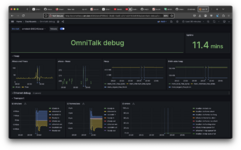I'm definitely intested - especially since it seems like the ESP32 can be coerced into a Localtalk interface for other host computers (like an Apple II)Following on from the 'What should a hobbyist-focussed AppleTalk router do' thread in the Networking subforum, some new prototype boards arrived in the post a few days ago. I haven't brought all the peripherals up yet, but here's a thread to whet people's appetites.
View attachment 41481
This board contains all the hardware needed for a new LocalTalk to Ethernet gateway. It's about the same size as an AsantéTalk.
The microcontroller, in the bottom left, is an ESP32. The prototype board has a version with extra RAM: I'm unsure if this'll be necessary in production units. I managed to order the wrong one, and got one with an onboard antenna, which is obviously pretty useless over all that ground plane. It was meant to be the one with a u.FL socket on it, so that if I decide WiFi is a good idea, an offboard antenna can be used.
The main reason for using the ESP32 (aside from liking the tooling), however, is that it has an Ethernet MAC on board. Above the ESP32 you can see a small chip, which is a 10/100BaseT Ethernet PHY, specifically a Microchip LAN8720. This has really nice documentation adapted to the meanest understanding, that even a software idiot like me can more or less follow. A modern Ethernet interface will give a big advantage over "period" gateways already, simply by being able to do things like MDI-X, autonegotiation and 100BaseT good enough for picky crappy home switches.
To the right of that is the LocalTalk interface, which is only partially populated at the moment. This is essentially the same LocalTalk hardware that's in AirTalk, with a nice pretty filtering network (which is identical to the filtering networks in a period Mac). Below that are a pair of RS485 drivers—unlike certain popular projects, I know what a line driver is for and am not attempting to do this off a GPIO pin of a microcontroller ;-). It's interesting—I found a handful of RS485 drivers that are kind of enhanced clones of older TI chips, offering a wider supply voltage range and some other nice improvements that the parent chip doesn't have. The datasheets are all in Chinese, but the tables are the important thing (and I'm starting to spot phrases like 'unit load' in them now, this is a bad way to learn languages, please send help).
To the right of that is a USB UART. This is intended for use as a firmware flashing interface, but it could also be used as an application serial port, and perhaps support for ARA over serial or something could be implemented. Who knows.
Obviously, this is nowhere near a production product yet. I don't even know if the Ethernet interface works properly yet, let alone how to make it into a nice physical object. But people seemed pretty interested, so here we go...
The fujinet project is a parallel system that can meet certain networking needs as well, so I'm excited for the ESP32 future


